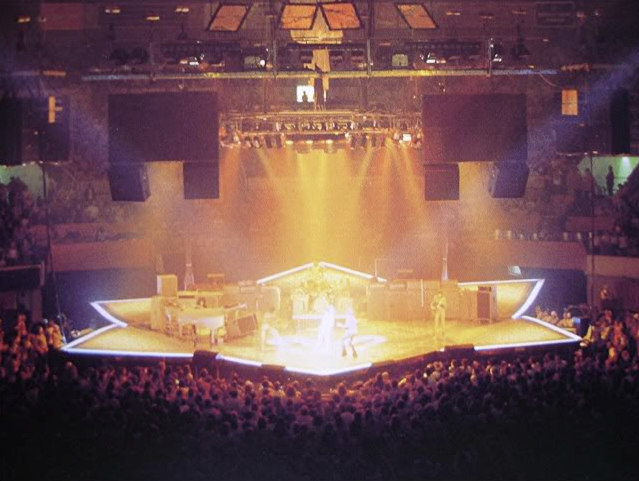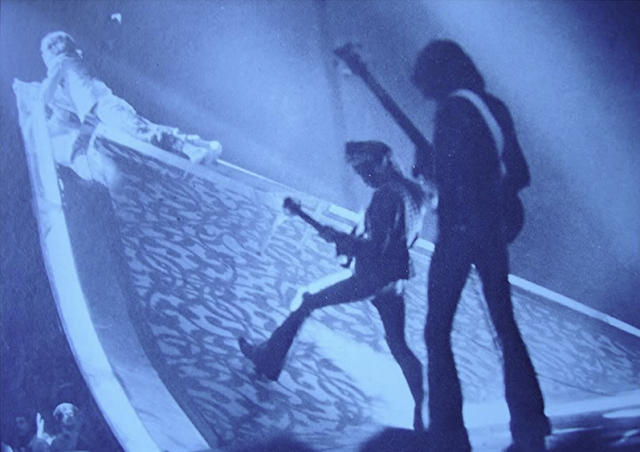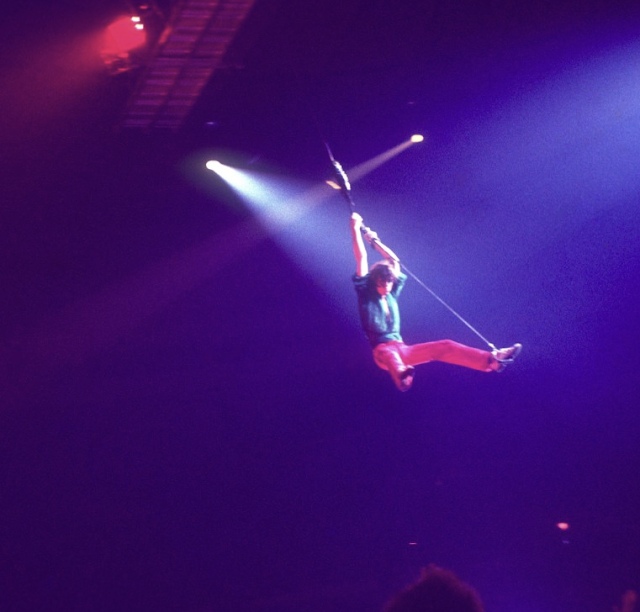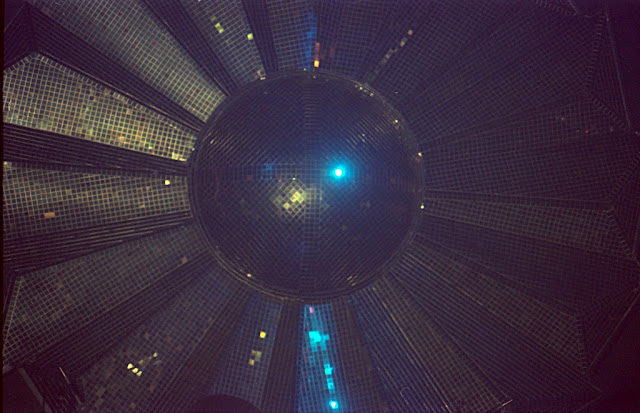Photo: Roland Feria
The Lotus Flower shaped stage was the centerpiece of the show which also featured an inflatable phallus, a confetti puffing dragon, and Jagger on a trapeze rope. At some of the major dates the audiences were treated to calypso dancers, steel drummers, a Chinese dragon that would weave through the crowd, as well as billowing fabric drapes and blinking lights that arched up from the lighting truss and flew over the crowd. The dull cold arenas they performed in were transformed into magical Asian themed temples of rock n roll that left audiences wowed and was truly the beginning of the Rolling Stones stage spectacle that has continued until this day. The impressive stage which was conceptualized by drummer Charlie Watts (RS Issue 191) and designed by famed theatrical designer Robin Wagner , who was a pioneer for large scale automated scenery.
Photo: Roland FeriaThe design featured huge triangle shaped petals that were closed at the beginning of the show and would slowly open during the opening number 'Honky Tonk Women'. As they opened, Mick Jagger would be towards the top of the center petal peaking over into the audience as it lowered down revealing the band.
Photo: Christopher Simon Sykes
If you go to the 14:12 mark in the below video you can view very rare footage of Mick being lowered on the petal:
Photo: Christopher Simon Sykes
The front petals would raise up slightly during the show during certain numbers and would close fully at the end of the show. The stage although not in the middle of the arena allowed seating all around it but the band primarily played to the front of the stage. The stage floor was ornately decorated with an intricate floral/paisley like pattern. The stage was also gently raked in elevation with the back being 8 feet high and the front 4 feet high.It should be noted that the Stones 1976 Europe tour featured a re-floored stage that was much less intricate and had a maze-like pattern on it. It also did not have the neon lighting running inside the outer edges and instead had yellow and blue lightbulbs along the outer edges. (see photos here 1, 2, 3).
Photo: Neil Fitzpatrick
Two stages were used, one that featured blue and red neon lights built into it that were covered by clear plexiglass as to shine through, and hydraulics that opened and closed the petals was used on the East and West coast as well as the Chicago show, while the one without hydraulics and neon lights was used on the other indoor arena dates. Both stages had foot wide strips of mirror outlining each petal which were rumored to be used not only for looks but as a warning strip for the often stoned band so they wouldn't walk over the edge.
Here is the blueprint for the hydraulic equipped stage:
Here is the blueprint for the hydraulic equipped stage:
Photo: Roland Feria
The outside of the petals that did open and close were covered in strips of aluminum that gave it a mirror look and created a beautiful effect at the beginning of the show when the spotlights would reflect off of them and into the audience.
Photo: Christopher Simon Sykes
As can be seen in the above photo, the band would be concealed by hanging fabric that would be lit in purple and would be pulled up into the lighting truss as the petals lowered with Mick at the very top of the center petal peaking out at the crowd.
Below is a great shot taken before the show at Madison Square Garden. You can see the steel drummers and their drums at the front of the stage.
The show was lit by Broadway veteran Jules Fisher who had designed stages for David Bowie and would go on to design stages for Kiss (see post here). Interviewed on the beggining of the tour Jules Fischer told Rolling Stone magazine "Wait till you see the Madison Square Garden show, It'll be decorated like a garden: hundreds of leaves on cables leading to the stage and the petals of the stage will be closed to resemble a tree trunk. The petals will open to show the band and Mick will rise on an elevator and we'll project flying eagles all over the audience.(see photo here) The leaves, ten-foot leaves will rise on hydraulic pistons and there'll be neon rimming on the stage. It'll be beautiful."(RS Issue 191) According to Dave Marsh in Rolling Stone, the 350 ten-foot leaves made of white gauze with silver foil trim removed from the ceiling of Madison Square Garden before the show because they were considered ineffective and too much of a temptation to the hands of the audience. (Reference)
As seen in the lighting plot above, the lighting rig was circular in shape which was very cutting edge at the time and featured a mix of Par 64 and Par 36 cans as can be seen in the photo below. It also featured super trooper spotlights on either side of the stage at 45 degree angles towards the back of the arenas. *These same lights had been used on the 1972 stage where they were used very effectively in a effect designed by Chip Monk. They were on stage behind the band pointed up towards the ceiling and would bounce off a huge mirror that was over the stage. (See photos here 1 2 and video)
Below is a photo taken at the Madison Square Garden show just before showtime. You will notice the blue "christmas" lights strung out over the crowd from the lighting rig, and the cluster of lights prominent in the photo that were projecting the eagles that Fischer had mentioned. You can also see in the front rows around the stage, the steel drummers and calypso band hired for the show. They would play before the intro of "Fanfare for the Common Man" signaled the start of the show.
Photo: Christopher Simon Sykes
Photo: Christopher Simon Sykes
The show was lit by Broadway veteran Jules Fisher who had designed stages for David Bowie and would go on to design stages for Kiss (see post here). Interviewed on the beggining of the tour Jules Fischer told Rolling Stone magazine "Wait till you see the Madison Square Garden show, It'll be decorated like a garden: hundreds of leaves on cables leading to the stage and the petals of the stage will be closed to resemble a tree trunk. The petals will open to show the band and Mick will rise on an elevator and we'll project flying eagles all over the audience.(see photo here) The leaves, ten-foot leaves will rise on hydraulic pistons and there'll be neon rimming on the stage. It'll be beautiful."(RS Issue 191) According to Dave Marsh in Rolling Stone, the 350 ten-foot leaves made of white gauze with silver foil trim removed from the ceiling of Madison Square Garden before the show because they were considered ineffective and too much of a temptation to the hands of the audience. (Reference)
As seen in the lighting plot above, the lighting rig was circular in shape which was very cutting edge at the time and featured a mix of Par 64 and Par 36 cans as can be seen in the photo below. It also featured super trooper spotlights on either side of the stage at 45 degree angles towards the back of the arenas. *These same lights had been used on the 1972 stage where they were used very effectively in a effect designed by Chip Monk. They were on stage behind the band pointed up towards the ceiling and would bounce off a huge mirror that was over the stage. (See photos here 1 2 and video)
Below is a photo taken at the Madison Square Garden show just before showtime. You will notice the blue "christmas" lights strung out over the crowd from the lighting rig, and the cluster of lights prominent in the photo that were projecting the eagles that Fischer had mentioned. You can also see in the front rows around the stage, the steel drummers and calypso band hired for the show. They would play before the intro of "Fanfare for the Common Man" signaled the start of the show.
Photo: Christopher Simon Sykes
Here is the stage being set up for the first time at the tours first stop in Baton Rouge.
Photo: Annie Leibovitz
Below the same non-hydraulic equipped stage is constructed in Minneapolis.
During Star Star and inflatable phallus would come through the center of the stage and wave madly in the air as Jagger would ride it and on some occasions attack it until it deflated back into the stage. It was nicknamed "tired grandfather" by the band because of its inability to stay upright. The prop was controversial and in San Antonio, a judge told the Stones management that if they used the prop, the concert would be shut down. They decided not to use it on that stop but it was used at all the other indoor arena shows.
Photo: Bob Gruen
Photo: Christopher Simon Sykes
The footage below taken from the Los Angeles Forum show on July 7th is interesting as the penis has been transformed into a middle finger complete with nail and and knuckle markings.
The footage below taken from the Los Angeles Forum show on July 7th is interesting as the penis has been transformed into a middle finger complete with nail and and knuckle markings.
Billy Preston who was the touring keyboardist with the band at the time was given two songs during the set "That's Life" and "Outta Space", during the latter, a trapeze rope would descend from the lighting rig and Jagger would swing out over the first 5 or so rows of the audience, making sure everyone knew that he was still the ringleader of this circus.
Above and bottom right Photo: Roland Feria
At the climax of the shows during Jumping Jack Flash, Jagger would bring out a dragon head that had an inflatable tongues that would lap at the audience in the front row and would spew confetti into the air.
The shows in MSG and LA ended with Sympathy for the Devil with the steel drummers and dancers circling the stages as the petals closed around the band ending what was for many Stones fans, the ultimate concert and tour.
At the 7:12 mark in the below video, you can see Mick Jagger re-enter the stage via the elevator located in front of Charlie Watts drum platform, the same hole in which the phallus and the dragon come out of.
You can click here for a 30 minute audio interview with Mick Jagger from June 11, 1975 where Mick discusses the stage design.
For anyone intersted in doing further research, I would recommend tracking down the 1978 book The Rolling Stones On Tour by Sykes, Liebovitz, and Southern, a lot of the images used in this post were taken from that book. For those with some extra cash on hand, Genesis publications produced a deluxe leather bound book The Rolling Stones Tour of the America's 75, by Sykes, Rudge, and Jagger for a cool $700.
Special thanks to the people on IORR.org that helped with me with this piece, especially Roland Feria, and Richard Galbraith.
Photo: Christopher Simon Sykes
At the 7:12 mark in the below video, you can see Mick Jagger re-enter the stage via the elevator located in front of Charlie Watts drum platform, the same hole in which the phallus and the dragon come out of.
You can click here for a 30 minute audio interview with Mick Jagger from June 11, 1975 where Mick discusses the stage design.
For anyone intersted in doing further research, I would recommend tracking down the 1978 book The Rolling Stones On Tour by Sykes, Liebovitz, and Southern, a lot of the images used in this post were taken from that book. For those with some extra cash on hand, Genesis publications produced a deluxe leather bound book The Rolling Stones Tour of the America's 75, by Sykes, Rudge, and Jagger for a cool $700.
Special thanks to the people on IORR.org that helped with me with this piece, especially Roland Feria, and Richard Galbraith.

































































